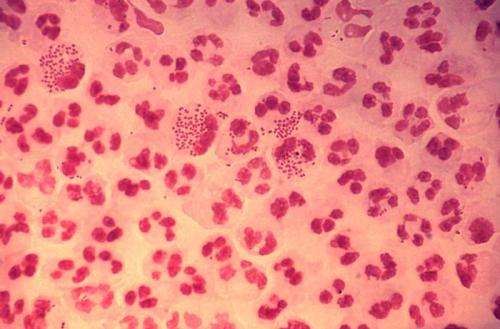Antibiotic treatment speeds up spread of resistance in the gonorrhea superbug

Neisseria gonorrhoeae is a sexually transmitted bacterium that has developed broad resistance against antibiotics. A study published on May 19th in PLOS Pathogens suggests that screening and treatment of infected patients might actually spread resistance against the one remaining recommended treatment. Moreover, while intuitively compelling, frequent change of sexual partners does not appear to be a major driver of the spread of antibiotic resistance.
Current public health efforts aim to reduce the overall burden of N. gonorrhoeae infection by expanded screening and treatment of sexually active individuals. Concerned about the uncertain consequences of this strategy for antibiotic resistance, Stephanie Fingerhuth and Christian Althaus from ETH Zurich, Switzerland, together with colleagues, used mathematical modelling to understand what drives the spread of resistance.
The researchers used data from two different surveillance programs (one in the US and one in England and Wales) for N. gonorrhoeae to estimate how fast resistant strains spread in two different host populations, namely in men who have sex with men (MSM) and in heterosexual men. They found that resistant strains spread much faster in MSM, with an estimated doubling time of 6 months compared with 16 months in heterosexual men.
The researchers also obtained data on the prevalence (the overall number of cases at a given time) and incidence (the number of new cases per year) of N. gonorrhoeae infection, and on sexual behavior among MSM and heterosexual men and women (HMW). They then used all of the data to calibrate a mathematical model that could predict the spread of antibiotic-resistant N. gonorrhoeae in the different populations.
The model predicted a much faster spread of resistant strains in MSM. On average, MSM do have more sexual partners than HMW. However, the intuitive argument that a faster spread of an infection, due to a higher number of sexual partners, will result in a faster spread of resistance did not hold. Rather than the higher number of partners, it was the higher level of antibiotic treatment for N. gonorrhoeae infections among MSM (presumably because they more frequently develop symptoms or seek out screening for STIs) that was responsible for the faster spread of resistance.
Like all mathematical modeling studies, this one used some simplifying assumptions. For example, the researchers assumed that resistant and susceptible strains have the same 'fitness' (i.e., capability to infect and multiply in the host), and that hosts are only infected with either a resistant or a susceptible strain, but not both. While, in view of these assumptions, the results carry some uncertainty, they nonetheless strongly suggest that treatment rate is the main driving force of resistance spread.
This has obvious implications. As the researchers discuss, "as higher treatment rates result in faster spread of antibiotic resistance, treatment recommendations for N. gonorrhoeae should carefully balance prevention of infection and avoidance of resistance spread."
More information: Fingerhuth SM, Bonhoeffer S, Low N, Althaus CL (2016) Antibiotic-ResistantNeisseria gonorrhoeae Spread Faster with More Treatment, Not More Sexual Partners. PLoS Pathog 12(5): e1005611. DOI: 10.1371/journal.ppat.1005611


















